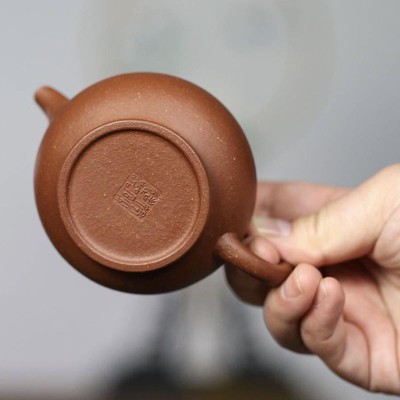








A flattened persimmon-shaped teapot is called a "Short Pan," a slightly taller and flattened spherical-shaped teapot is called a "Medium Pan," and a teapot with a taller and pear-shaped body is called a "Tall Pan." When their daughters got married, they would give a Pan teapot as part of their dowry, hoping that their daughters would be able to live a prosperous life like "Pan Shicheng" who the inventor of the "pan" teapot. teapots that are passed down as part of the dowry are not necessarily used for brewing tea, but can also be placed on dressing tables to hold hair oil. After the female owner passes away, they are often used as burial objects to show gratitude to her family for raising her.
 Delivery
Delivery
Free shipping within 1 to 3 days. ETA:5-7 days
 Returns
Returns
Within 28 days after delivery date.
 Security
Security
SSL | GDRP used to ensure information security.
Guarantee safe & secure checkout
Data sheet
The design of this yixing teapot is very much in line with Chinese style, I love it! It's very easy to use and the tea it brews is more fragrant and rich. Definitely worth buying!I prepared one for my daughter, and in China this teapot also represents a blessing.
A flattened persimmon-shaped teapot is called a "Short Pan," a slightly taller and flattened spherical-shaped teapot is called a "Medium Pan," and a teapot with a taller and pear-shaped body is called a "Tall Pan." When their daughters got married, they would give a Pan teapot as part of their dowry, hoping that their daughters would be able to live a prosperous life like "Pan Shicheng" who the inventor of the "pan" teapot. teapots that are passed down as part of the dowry are not necessarily used for brewing tea, but can also be placed on dressing tables to hold hair oil. After the female owner passes away, they are often used as burial objects to show gratitude to her family for raising her.
A flattened persimmon-shaped teapot is called a "Short Pan," a slightly taller and flattened spherical-shaped teapot is called a "Medium Pan," and a teapot with a taller and pear-shaped body is called a "Tall Pan." When their daughters got married, they would give a Pan teapot as part of their dowry, hoping that their daughters would be able to live a prosperous life like "Pan Shicheng" who the inventor of the "pan" teapot. teapots that are passed down as part of the dowry are not necessarily used for brewing tea, but can also be placed on dressing tables to hold hair oil. After the female owner passes away, they are often used as burial objects to show gratitude to her family for raising her.
Pear-shaped yixing teapot,it is one of the pot styles that originated in the Chian Yuan Dynasty and became popular during the China Ming Dynasty. It is named after its pear-like shape.
"Shipiao" Yixing teapot- this zisha teapot is a traditional Chinese tea set characterized by its gourd-like or calabash-like shape, with a small top and large bottom, a sturdy and short spout, and a pyramid-shaped body that exudes elegance. Made from high-quality purple clay material, this teapot is known for its hardness and durability, as well as its stable and easy-to-use design. The short and powerful straight spout ensures a smooth and steady flow of water, while the pyramid-shaped body adds a touch of sophistication to any tea ceremony.
A flattened persimmon-shaped teapot is called a "Short Pan," a slightly taller and flattened spherical-shaped teapot is called a "Medium Pan," and a teapot with a taller and pear-shaped body is called a "Tall Pan." When their daughters got married, they would give a Pan teapot as part of their dowry, hoping that their daughters would be able to live a prosperous life like "Pan Shicheng" who the inventor of the "pan" teapot. teapots that are passed down as part of the dowry are not necessarily used for brewing tea, but can also be placed on dressing tables to hold hair oil. After the female owner passes away, they are often used as burial objects to show gratitude to her family for raising her.
"Xubian" yixing teapot is considered one of the most challenging shapes to create in traditional handmade purple clay pottery. In fact, it's said in the industry that "one point of shaping equals one point of difficulty in forming." To create this teapot, the potter must start with a cylindrical shape and then use a "clay pat" to gently tap and flatten the clay without causing it to collapse. This requires a great deal of skill and precision in manual operation, making it a difficult and time-consuming process. Despite the challenges, the Xubian teapot is highly valued by collectors and tea enthusiasts for its unique and elegant shape, as well as its ability to brew tea with a rich and full flavor.
"Shipiao" Yixing teapot- this zisha teapot is a traditional Chinese tea set characterized by its gourd-like or calabash-like shape, with a small top and large bottom, a sturdy and short spout, and a pyramid-shaped body that exudes elegance. Made from high-quality purple clay material, this teapot is known for its hardness and durability, as well as its stable and easy-to-use design. The short and powerful straight spout ensures a smooth and steady flow of water, while the pyramid-shaped body adds a touch of sophistication to any tea ceremony.
"Xiaoying" yixing zisha teapot - This zisha teapot embodies the Chinese values of peace, harmony, and pursuit of happiness. Its name "xiaoying" means "smiling and peaceful," reflecting an optimistic and open-minded attitude. Although the teapot itself does not have a smile, its pot body exudes a sense of joy and contentment, making the viewer feel its "smile" meaning.
"Fanggu" Yixing Teapot - This zisha teapot has an antique cylindrical body shaped like a drum, with a short neck imitating the shape of a drum pot. The spout is also designed to imitate the shape of a drum pot spout, with a straight line. Its advantages include excellent heat preservation, natural color, comfortable texture, and long service life. The "Fanggu" teapot is a unique and elegant choice for tea lovers and collectors alike.
As a shape, "Ruyi" is a common pattern and object shape in traditional Chinese culture,the "Ruyi" shape represents auspicious, happiness, and good meanings in Chinese culture.
"Meirenjian" yixing teapot resembles an ancient woman, dignified and lovely, with a hint of palace elegance and grace, yet without losing the charm of a young lady. The shape is full and elegant, mainly reflecting the roundness of the pot body. The pot cover and the pot body seem to be integrated without any gaps. When touched by hand, one can feel its warmth.
"Shipiao" Yixing teapot- this zisha teapot is a traditional Chinese tea set characterized by its gourd-like or calabash-like shape, with a small top and large bottom, a sturdy and short spout, and a pyramid-shaped body that exudes elegance. Made from high-quality purple clay material, this teapot is known for its hardness and durability, as well as its stable and easy-to-use design. The short and powerful straight spout ensures a smooth and steady flow of water, while the pyramid-shaped body adds a touch of sophistication to any tea ceremony.
The apple-shaped Yixing teapot is another unique example of zisha teapot. As the name suggests, it is designed to resemble an apple.
"Shipiao" Yixing teapot- this zisha teapot is a traditional Chinese tea set characterized by its gourd-like or calabash-like shape, with a small top and large bottom, a sturdy and short spout, and a pyramid-shaped body that exudes elegance. Made from high-quality purple clay material, this teapot is known for its hardness and durability, as well as its stable and easy-to-use design. The short and powerful straight spout ensures a smooth and steady flow of water, while the pyramid-shaped body adds a touch of sophistication to any tea ceremony.
This teapot has a cute and silly appearance, so it's named "Han Piao".
The "Dabin-Ruyi" is a classic Yixing teapot designed and made for Dabin during the Ming Dynasty. Dabin designed this teapot with the meaning of "everything goes as desired" .The lid is convex and serves as a cover. The lid is decorated with four symmetrical Ruyi patterns, with a thickness of about 1 millimeter and exquisite craftsmanship. The knob is flat and round, and there is an air hole in the center of the lid that is connected to the knob. The hole in the lid is large, while the hole in the knob is small and round, with precise workmanship. The "sanwan" spout are inwardly curved, giving the teapot a dignified and refined appearance. The Dabin-Ruyi teapot is simple and elegant, with a grandeur that is not overwhelming, fully reflecting the style of Dabin's teapot making.
The design of the Palace Lamp "Gongdeng" in the Yongzheng period of the Qing Dynasty. Its prototype was a lantern, designed by an old man from Tuntou Village. Later, the Tuntou Lantern was presented as a tribute to a county-level official who took it to the palace. The Tuntou Lantern was named "Gongdeng" and became an exclusive item for the imperial palace. Later, people replaced the character "Gong" with "Palace," and it became the "Palace Lamp" we know today. The Palace Lamp teapot is designed based on this lantern, often appearing in a square shape with a fresh, natural, and elegant style that is in line with the aesthetic views of ancient people and easily accepted by modern people.
"Duozhi" yixing teapot is a unique and distinctive shape in the world of Yixing zisha teapots. Its shape resembles a pile of spheres and hemispheres stacked together, giving it a unique and eye-catching appearance. The name "Duo Zhi" comes from the Chinese word for "stacking and linking." Due to its unique appearance, this type of teapot is commonly referred to as the "Duozhi teapot." Interestingly, the name "Duozhi" in Chinese also carries a positive connotation, meaning "many children, much happiness." This adds to the charm and appeal of this teapot, making it a popular choice for collectors and tea enthusiasts alike.
"Jizhi" yixing teapot has a straight cylindrical body with a shoulder, short neck, and straight spout. The handle is free-flowing and ear-shaped, while the lid fits tightly. The bottom of the pot is neatly crafted with exquisite workmanship. The overall design of the pot displays a strong contrast between thick and thin lines, as well as between straight and curved lines, giving it a deep, simple, and powerful temperament. At the same time, it also exudes a sense of elegance and grace. It seems that the "Jizhi" teapot conveys a spirit of honesty and justice, daring to advise others.
"Hehuan" means "all happy",the zisha art master- "Mansheng" was inspired by the beautiful and harmonious sound of the cymbals coming together during the celebration. He believed that this sound brought joy and happiness to people, so he used the shape of the cymbals as a model to design the Hehuan teapot. He named it after the joyous sound they made when struck together, and the teapot's unique shape and design symbolize the harmony and beauty of life.
NOTICE : Cookies ensure the smooth running of our services and improve user experience,Using these, you accept the use of cookies. Learn More.